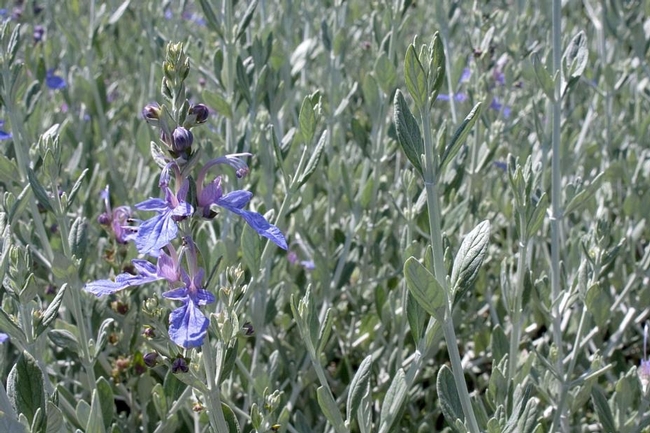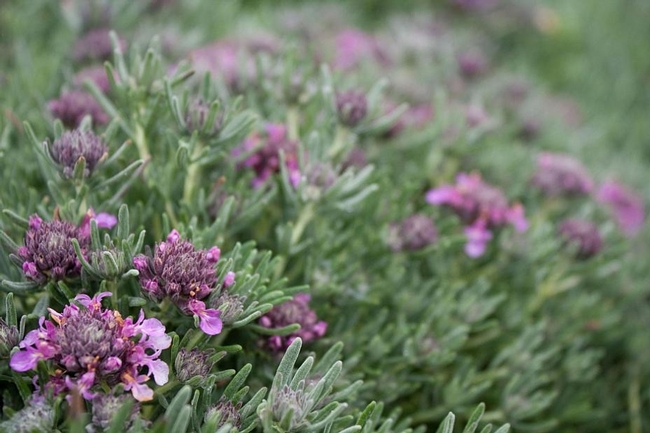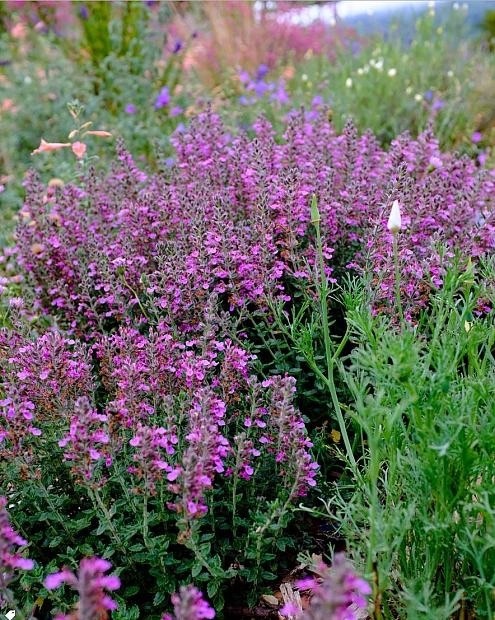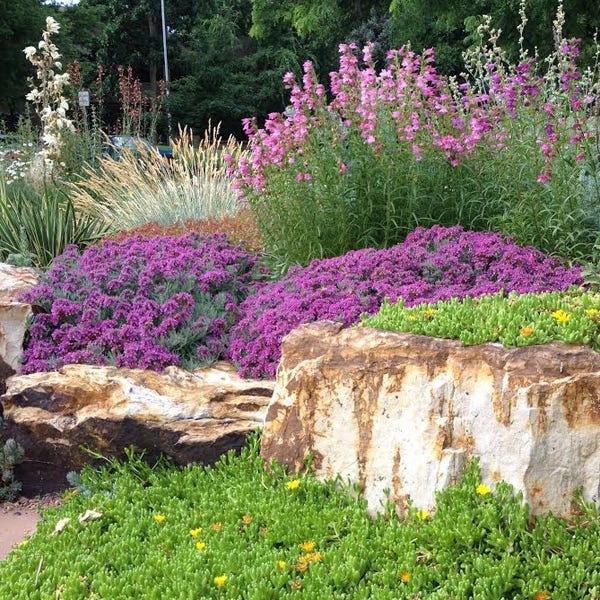One of the first gardening books I ever purchased was Sunset magazine's book How to Grow Herbs, published in the early 1970's. Though it had great information on cultivation and harvesting, what really drew me in was the use of herbs in landscaping. In particular I remember one black and white photo (no color back then!) of so-called wall germander. Now I lived in rainy Santa Cruz at the time, and I doubt that I had ever seen germander, but there was something about that photo that always stayed with me. From the book I learned that Teucrium chamaedrys was a major component of “knot gardens”—those very formal geometric gardens that became popular during the Elizabethan Age in England—along with thyme, marjoram, rosemary, Santolina and other herbs of Mediterranean origin.
While there are hundreds of species of germander, it's not a plant that seems to get much attention or respect. The Wikipedia entry for Teucrium isn't much more than a list of some of the species, and while Teucrium chamaedrys shows up in many nurseries, I doubt if one nursery in fifty has any other representatives from the genus. That's a shame, because these workhorses can fill a number of roles in the garden and are especially well-suited for tough growing environments like we have in the Eastern Sierra.
So it's not surprising that it was more than thirty years later, when I moved to the wilds of West Chalfant, that I grew my first germander, a prostrate form of Teucrium chamaedrys that—unlike just about anything else—seemed to thrive in this strange new land! Its evergreen character and attractive pink flowers in early summer were a bonus—a real bee magnet! The downside is that creeping germander can do just that if it gets sufficient water, so accept that aspect and plant it where it will have room to fill in. It is a groundcover, after all!
A few years later I found upright Teucrium chamaedrys, the wall germander (see photo above) I had seen in photos so long ago, and planted a few of those. Again, these are not show stoppers, but they are attractive year-round, grow to a foot or so in height, and do not spread. I have come to consider wall germander one of my go-to plants. Santolina and 'Powis Castle' Artemisia are two other sub-shrubs I count on for their pleasing shape and foliage—plants that make the colors in front of them really pop. But unlike those plants, germander never gets leggy or unkempt looking, remaining neat and green throughout the year. The only upkeep required is to cut back the spent blooms in midsummer (and hope for another show in the fall). I would characterize wall germander as one of my garden's best supporting actors!

Teucrium fruticans (shrubby germander or tree germander grows 4-6 feet high and wide) is another member of the genus I tried in my yard, but it was, for me, a real heartbreaker! In my research for drought-tolerant shrubs before moving to Chalfant, this is one that really caught my eye with its fuzzy gray foliage and transcendent blue flowers. I found a beautiful specimen at a nursery somewhere on the west side of the mountains, but it died pretty quickly. Undeterred, I had a friend buy me another one when she was in Berkeley, but it met the same fate. Though I've seen it rated as hardy to 0-10 degrees, most sources list it as zone 8 (10-20 degrees). For me, that's worth a try—Salvia greggii is listed as zone 8, for example, and it is a staple in Eastern Sierra gardens. Of course, the flip side is that plenty of zone 8 plants die! Anyway, if you've got a protected area and are willing to risk the money, you might give this one a try, because it really is a beautiful shrub.

Similar in character is Teucrium aroanium, gray creeping germander. If you have a tough, dry area you want to dress up with a unique, beautiful groundcover, you should really give these two a try. Mountain Valley Growers and High Country Gardens are good online sources for germander. If you're in Southern California, look for a bricks and mortar garden store that carries plants from Native Son wholesale nursery (who kindly allowed me to use their photos).
Living where I do, I am always searching for plants like germander: hard-to-kill, drought-tolerant, low-maintenance plants that look good year-round. Who isn't? I read somewhere that there are 260 species of Teucrium, and I know I'll be on the lookout for any I can find!
Resources: https://www.
https://www.mountainvalleygrowers.com/
https://www.nativeson.com/plants-overview (wholesale).

